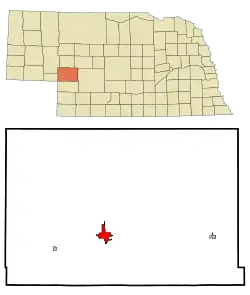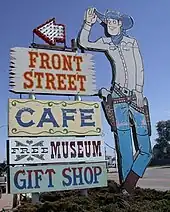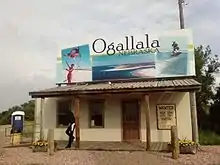Ogallala, Nebraska
Ogallala is a city in and the county seat of Keith County, Nebraska, United States.[3] The population was 4,737 at the 2010 census. In the days of the Nebraska Territory, the city was a stop on the Pony Express and later along the transcontinental railroad. The Ogallala Formation that carries the Ogallala Aquifer was named after the city.
Ogallala, Nebraska | |
|---|---|
 Front Street tourist attraction | |
 Location of Ogallala, Nebraska | |
| Coordinates: 41°07′46″N 101°43′15″W | |
| Country | United States |
| State | Nebraska |
| County | Keith |
| Founded | 1868 |
| Government | |
| • Type | City Council/City Manager |
| • Mayor | Deb Schilz |
| • City Manager | Bruce Smith |
| Area | |
| • Total | 5.02 sq mi (13.00 km2) |
| • Land | 4.96 sq mi (12.84 km2) |
| • Water | 0.06 sq mi (0.16 km2) |
| Elevation | 3,232 ft (985 m) |
| Population (2020) | |
| • Total | 4,878 |
| • Density | 984.06/sq mi (379.96/km2) |
| Time zone | UTC-7 (Mountain (MST)) |
| • Summer (DST) | UTC-6 (MDT) |
| ZIP code | 69153 |
| Area code | 308 |
| FIPS code | 31-35980 |
| GNIS feature ID | 2395305[2] |
| Website | ogallala-ne.gov |
History
Ogallala first gained fame as a terminus for cattle drives that traveled from Texas to the Union Pacific railhead located there. These trails are known as the Western or Great Western trails.[4][5] The Union Pacific Railroad reached Ogallala on May 24, 1867.[6] The city itself was not laid out until 1875 and not incorporated until 1884[7] The town's name comes from the Oglala Sioux tribe.[8]
Geography
According to the United States Census Bureau, the city has a total area of 5.02 square miles (13.00 km2), of which 4.96 square miles (12.85 km2) is land and 0.06 square miles (0.16 km2) is water.[9] Ogallala is in the US Mountain Time Zone (UTC−7/-6).
Ogallala is close to Lake McConaughy, a large man-made lake and a state recreation area with sandy beaches, boating and swimming. The South Platte River runs through Ogallala.
Climate
| Ogallala, Nebraska | ||||||||||||||||||||||||||||||||||||||||||||||||||||||||||||
|---|---|---|---|---|---|---|---|---|---|---|---|---|---|---|---|---|---|---|---|---|---|---|---|---|---|---|---|---|---|---|---|---|---|---|---|---|---|---|---|---|---|---|---|---|---|---|---|---|---|---|---|---|---|---|---|---|---|---|---|---|
| Climate chart (explanation) | ||||||||||||||||||||||||||||||||||||||||||||||||||||||||||||
| ||||||||||||||||||||||||||||||||||||||||||||||||||||||||||||
| ||||||||||||||||||||||||||||||||||||||||||||||||||||||||||||
Ogallala has a dry humid continental climate (Köppen Dfa), bordering on cold semi-arid with an annual average precipitation of 20.40 in (518 mm). Winters are cold, while summers are hot and often stormy. Precipitation is greatest in the late spring and summer, with winter being the driest part of the year.
| Climate data for Ogallala, Nebraska (1991–2020 normals, extremes 1893–present) | |||||||||||||
|---|---|---|---|---|---|---|---|---|---|---|---|---|---|
| Month | Jan | Feb | Mar | Apr | May | Jun | Jul | Aug | Sep | Oct | Nov | Dec | Year |
| Record high °F (°C) | 74 (23) |
78 (26) |
92 (33) |
95 (35) |
100 (38) |
108 (42) |
115 (46) |
109 (43) |
109 (43) |
95 (35) |
82 (28) |
76 (24) |
115 (46) |
| Mean maximum °F (°C) | 61.2 (16.2) |
66.7 (19.3) |
77.7 (25.4) |
85.0 (29.4) |
92.7 (33.7) |
98.6 (37.0) |
101.9 (38.8) |
99.2 (37.3) |
96.0 (35.6) |
87.0 (30.6) |
73.4 (23.0) |
63.0 (17.2) |
102.8 (39.3) |
| Average high °F (°C) | 39.7 (4.3) |
42.8 (6.0) |
53.4 (11.9) |
61.9 (16.6) |
71.8 (22.1) |
83.4 (28.6) |
89.6 (32.0) |
87.4 (30.8) |
79.2 (26.2) |
65.0 (18.3) |
51.4 (10.8) |
41.1 (5.1) |
63.9 (17.7) |
| Daily mean °F (°C) | 27.5 (−2.5) |
30.3 (−0.9) |
39.6 (4.2) |
48.2 (9.0) |
58.7 (14.8) |
70.0 (21.1) |
76.2 (24.6) |
74.1 (23.4) |
64.8 (18.2) |
50.7 (10.4) |
38.1 (3.4) |
28.8 (−1.8) |
50.6 (10.3) |
| Average low °F (°C) | 15.4 (−9.2) |
17.7 (−7.9) |
25.7 (−3.5) |
34.5 (1.4) |
45.6 (7.6) |
56.6 (13.7) |
62.9 (17.2) |
60.8 (16.0) |
50.4 (10.2) |
36.4 (2.4) |
24.7 (−4.1) |
16.4 (−8.7) |
37.3 (2.9) |
| Mean minimum °F (°C) | −5.4 (−20.8) |
−1.9 (−18.8) |
8.2 (−13.2) |
20.6 (−6.3) |
30.8 (−0.7) |
45.2 (7.3) |
53.6 (12.0) |
50.6 (10.3) |
36.5 (2.5) |
19.2 (−7.1) |
7.6 (−13.6) |
−2.1 (−18.9) |
−11.2 (−24.0) |
| Record low °F (°C) | −29 (−34) |
−26 (−32) |
−23 (−31) |
−2 (−19) |
19 (−7) |
32 (0) |
38 (3) |
37 (3) |
15 (−9) |
−2 (−19) |
−10 (−23) |
−36 (−38) |
−36 (−38) |
| Average precipitation inches (mm) | 0.51 (13) |
0.58 (15) |
1.12 (28) |
2.23 (57) |
3.22 (82) |
3.11 (79) |
2.90 (74) |
2.09 (53) |
1.53 (39) |
1.26 (32) |
0.59 (15) |
0.40 (10) |
19.54 (496) |
| Average snowfall inches (cm) | 4.6 (12) |
5.6 (14) |
3.7 (9.4) |
3.2 (8.1) |
0.2 (0.51) |
0.0 (0.0) |
0.0 (0.0) |
0.0 (0.0) |
0.0 (0.0) |
0.6 (1.5) |
2.6 (6.6) |
4.1 (10) |
24.6 (62) |
| Average precipitation days (≥ 0.01 in) | 2.8 | 4.0 | 5.4 | 7.8 | 10.5 | 9.5 | 8.3 | 7.0 | 5.3 | 5.6 | 3.5 | 2.8 | 72.5 |
| Average snowy days (≥ 0.1 in) | 2.9 | 4.0 | 2.5 | 1.7 | 0.1 | 0.0 | 0.0 | 0.0 | 0.0 | 0.6 | 1.7 | 2.6 | 16.1 |
| Source: NOAA[10][11] | |||||||||||||
Demographics
| Census | Pop. | Note | %± |
|---|---|---|---|
| 1880 | 114 | — | |
| 1890 | 494 | 333.3% | |
| 1900 | 355 | −28.1% | |
| 1910 | 643 | 81.1% | |
| 1920 | 1,062 | 65.2% | |
| 1930 | 1,631 | 53.6% | |
| 1940 | 3,159 | 93.7% | |
| 1950 | 3,456 | 9.4% | |
| 1960 | 4,250 | 23.0% | |
| 1970 | 4,976 | 17.1% | |
| 1980 | 5,638 | 13.3% | |
| 1990 | 5,095 | −9.6% | |
| 2000 | 4,930 | −3.2% | |
| 2010 | 4,737 | −3.9% | |
| 2020 | 4,878 | 3.0% | |
| U.S. Decennial Census[12] 2012 Estimate[13] | |||
2010 census
As of the census[14] of 2010, there were 4,737 people, 2,100 households, and 1,298 families living in the city. The population density was 955.0 inhabitants per square mile (368.7/km2). There were 2,397 housing units at an average density of 483.3 per square mile (186.6/km2). The racial makeup of the city was 94.6% White, 0.2% African American, 0.6% Native American, 0.4% Asian, 2.2% from other races, and 2.0% from two or more races. Hispanic or Latino of any race were 7.5% of the population.
There were 2,100 households, of which 27.5% had children under the age of 18 living with them, 48.0% were married couples living together, 9.6% had a female householder with no husband present, 4.2% had a male householder with no wife present, and 38.2% were non-families. 34.1% of all households were made up of individuals, and 14.6% had someone living alone who was 65 years of age or older. The average household size was 2.23 and the average family size was 2.85.
The median age in the city was 43.7 years. 23.6% of residents were under the age of 18; 6.8% were between the ages of 18 and 24; 21.4% were from 25 to 44; 28.3% were from 45 to 64; and 20.1% were 65 years of age or older. The gender makeup of the city was 48.8% male and 51.2% female.
2000 census
As of the census of 2000, there were 4,930 people, 2,052 households, and 1,339 families living in the city. The population density was 1,472.4 inhabitants per square mile (568.5/km2). There were 2,314 housing units at an average density of 691.1 per square mile (266.8/km2). The racial makeup of the city was 96.45% White, 0.02% African American, 0.87% Native American, 0.22% Asian, 1.68% from other races, and 0.75% from two or more races. Hispanic or Latino of any race were 4.79% of the population.
There were 2,052 households, out of which 31.5% had children under the age of 18 living with them, 53.0% were married couples living together, 9.5% had a female householder with no husband present, and 34.7% were non-families. 30.7% of all households were made up of individuals, and 14.7% had someone living alone who was 65 years of age or older. The average household size was 2.35 and the average family size was 2.94.
In the city, the population was spread out, with 26.5% under the age of 18, 6.7% from 18 to 24, 26.5% from 25 to 44, 21.9% from 45 to 64, and 18.4% who were 65 years of age or older. The median age was 39 years. For every 100 females, there were 89.0 males. For every 100 females age 18 and over, there were 85.0 males.
As of 2000 the median income for a household in the city was $32,141, and the median income for a family was $39,688. Males had a median income of $27,436 versus $18,292 for females. The per capita income for the city was $17,674. About 5.0% of families and 7.8% of the population were below the poverty line, including 9.3% of those under age 18 and 9.1% of those age 65 or over.
Education


Public schools
Ogallala is served by the Ogallala Public School District [15]
- High School—Ogallala High School
- Elementary and Middle School—Prairie View School (grade PK-8)
Private schools
- St. Paul's Lutheran School (PreK-5)
- St. Luke's Catholic School (PreK-5)
Media
Radio
Newspaper
- Keith County News (bi-weekly)
Point of interest
The Ogallala post office contains an oil-on-canvas mural, titled Long Horns, painted in 1938 by Frank Mechau. Murals were produced from 1934 to 1943 in the United States through the Section of Painting and Sculpture, later called the Section of Fine Arts, of the Treasury Department.[16]
Transportation
Intercity bus service to the city is provided by Burlington Trailways and Express Arrow.[17][18] Within the city, Ogallala Public Transit provides dial-a-ride service.[19]
Notable people
- John Lanigan – longtime morning radio host at WMJI in Cleveland; National Radio Hall of Fame inductee
- Ken Schilz – Nebraska state senator
- Thomas Shanahan – United States federal judge
References
- "ArcGIS REST Services Directory". United States Census Bureau. Retrieved September 18, 2022.
- U.S. Geological Survey Geographic Names Information System: Ogallala, Nebraska
- "Find a County". National Association of Counties. Archived from the original on May 31, 2011. Retrieved June 7, 2011.
- Skaggs, Jimmy M. "WESTERN TRAIL". Handbook of Texas Online. exas State Historical Association. Retrieved July 20, 2010.
- Busby, Myra. "Along The Great Western Cattle Trail". www.greatwesterncattletrail.com. Archived from the original on October 7, 2014. Retrieved July 20, 2010.
- "Union Pacific End of Track Dateline 1865-1869" (GIF). Historical Maps of the Union Pacific. Union Pacific Railroad Company. Retrieved July 20, 2010.
- Seltzer, Leon, ed. (1952), "Ogallala, Nebraska", Columbia Lippincott Gazetteer of the world: Lippincott's pronouncing gazetteer, New York: Columbia University Press, p. 1378
- "history of ogallala..." Official Website, City of Ogallala. City of Ogallala. Archived from the original on May 17, 2012. Retrieved August 19, 2012.
- "US Gazetteer files 2010". United States Census Bureau. Archived from the original on January 12, 2012. Retrieved June 24, 2012.
- "NOWData - NOAA Online Weather Data". National Oceanic and Atmospheric Administration. Retrieved November 29, 2021.
- "Station: Ogallala, NE". U.S. Climate Normals 2020: U.S. Monthly Climate Normals (1991-2020). National Oceanic and Atmospheric Administration. Retrieved November 29, 2021.
- United States Census Bureau. "Census of Population and Housing". Retrieved October 18, 2013.
- "Annual Estimates of the Resident Population: April 1, 2010 to July 1, 2012". Archived from the original on June 2, 2013. Retrieved October 18, 2013.
- "U.S. Census website". United States Census Bureau. Retrieved June 24, 2012.
- "Ogallala Public School District". www.opsd.org. Retrieved July 20, 2010.
- Park, Marlene and Gerald E. Markowitz, Democratic vistas: Post Offices and Public Art in the New Deal, Temple University Press, Philadelphia 1984
- "Nebraska Bus Stops". Retrieved July 20, 2023.
- "Locations". Retrieved July 20, 2023.
- "Ogallala Public Transit". Retrieved July 20, 2023.
External links
- City of Ogallala
 Geographic data related to Ogallala, Nebraska at OpenStreetMap
Geographic data related to Ogallala, Nebraska at OpenStreetMap